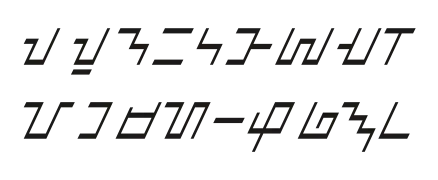Buhid script
Surat Buhid is an abugida used to write the Buhid language. As a Brahmic script indigenous to the Philippines, it closely related to Baybayin and Hanunó'o. It is still used today by the Mangyans, found mainly on island of Mindoro, to write their language, Buhid, together with the Filipino latin script.
| Buhid (Mangyan Baybayin, Surat Mangyan) ᝊᝓᝑᝒ | |
|---|---|
 | |
| Script type | |
Time period | c. 1300–present |
| Direction | left-to-right |
| Languages | Buhid, Tagalog[1] |
| Related scripts | |
Parent systems | |
Sister systems | In the Philippines: Hanunó'o (Mangyan Baybayin, Surat Mangyan) In Indonesian Archipelago: Balinese Batak Javanese Lontara Sundanese Rencong Rejang |
| ISO 15924 | |
| ISO 15924 | Buhd (372), Buhid |
| Unicode | |
Unicode alias | Buhid |
| U+1740–U+175F | |
[a] The Semitic origin of the Brahmic scripts is not universally agreed upon. | |
| Brahmic scripts |
|---|
| The Brahmi script and its descendants |
There are efforts to reinvigorate the use of Surat Buhid.[2] Buhid script use varies across Northern (Bansud area) and Southern Buhid (Bongabong) communities.[3]
Structure
The Buhid script has 18 independent characters; 15 are consonants and 3 vowels. As an abugida, there are additional diacritic vowels. Consonants have an inherent /a/ vowel. The other two vowels are indicated by a diacritic above (for /i/) or below (for /u/) the consonant. Depending on the consonant, ligatures are formed, changing the shape of the consonant-vowel combination.[4] Vowels at the beginning of syllables are represented by their own, independent characters. Syllables ending in a consonant are written without the final consonant.[5]
Letters
The letter order of Buhid, recorded in Unicode, is based on phonetic principles that consider both the manner and place of articulation of the consonants and vowels they represent.
Vowels
| Buhid Vowels | |||||
|---|---|---|---|---|---|
| Initial | Dependent | ||||
| transcription | a | i | u | i | u |
| letter | ᝀ | ᝁ | ᝂ | ᝒ | ᝓ |
Consonants
| Buhid Syllables[4] | ||||||||||||||||||
| transcription | k | g | ng | t | d | n | p | b | m | y | r | l | w | s | h | |||
| consonant + a | ᝃ | ᝄ | ᝅ | ᝆ | ᝇ | ᝈ | ᝉ | ᝊ | ᝋ | ᝌ | ᝍ | ᝎ | ᝏ | ᝐ | ᝑ | |||
| consonant + i | ᝃᝒ | ᝄᝒ | ᝅᝒ | ᝆᝒ | ᝇᝒ | ᝈᝒ | ᝉᝒ | ᝊᝒ | ᝋᝒ | ᝌᝒ | ᝍᝒ | ᝎᝒ | ᝏᝒ | ᝐᝒ | ᝑᝒ | |||
| consonant + u | ᝃᝓ | ᝄᝓ | ᝅᝓ | ᝆᝓ | ᝇᝓ | ᝈᝓ | ᝉᝓ | ᝊᝓ | ᝋᝓ | ᝌᝓ | ᝍᝓ | ᝎᝓ | ᝏᝓ | ᝐᝓ | ᝑᝓ | |||
Note: With the proper rendering support, the Buhid syllable ki above (ᝃᝒ) should resemble a plus sign (+).
Buhid writing makes use of single (᜵) and double (᜶) punctuation marks.[4]
Unicode
Buhid script was added to the Unicode Standard in March, 2002 with the release of version 3.2.
The Unicode block for Buhid is U+1740–U+175F:
| Buhid[1][2] Official Unicode Consortium code chart (PDF) | ||||||||||||||||
| 0 | 1 | 2 | 3 | 4 | 5 | 6 | 7 | 8 | 9 | A | B | C | D | E | F | |
| U+174x | ᝀ | ᝁ | ᝂ | ᝃ | ᝄ | ᝅ | ᝆ | ᝇ | ᝈ | ᝉ | ᝊ | ᝋ | ᝌ | ᝍ | ᝎ | ᝏ |
| U+175x | ᝐ | ᝑ | ᝒ | ᝓ | ||||||||||||
| Notes | ||||||||||||||||
References
- "Buhid language and alphabet".
- Catapang, Emerenciana (2014). "Reviving the Hanunoo and Buhid Mangyan syllabic scripts of the Philippines" (PDF). Proceedings of the International Workshop on Endangered Scripts of Island Southeast Asia.
- "Buhid". Mangyan Heritage Center. Archived from the original on 2020-11-01.
- "Chapter 17: Indonesia and Oceania" (PDF). Unicode Consortium. March 2020.
- Everson, Michael (1998-11-23). "N1933 Revised proposal for encoding the Philippine scripts in the UCS" (PDF).